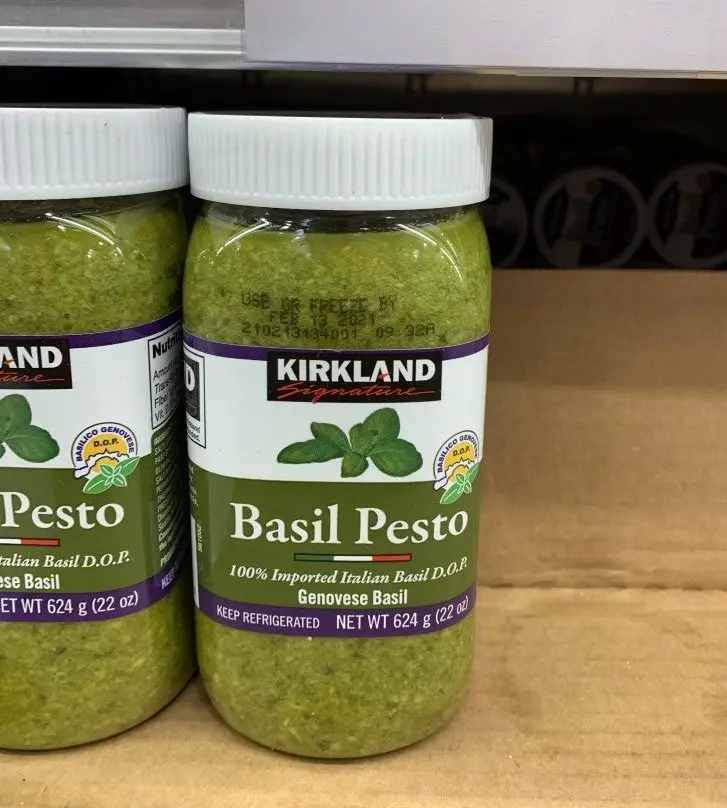How Long Does Homemade Pesto Last in the fridge?
Jump To:
Pesto Sauce is a typical green sauce that has its origins in Genoa, Italy. Pesto sauce is traditionally made with simple ingredients like fresh basil, garlic, Parmesan cheese, pine nuts, and olive oil. The crushing of these ingredients using a mortar and pestle gave us Pesto sauce. When you save the Pesto, Sauce is kept in home fridges, and the question always arises: how long does homemade Pesto last in the refrigerator.

Homemade Pasta Sauce tastes much better than store-bought Pesto Sauce as it does not go through the procession. Made at home Pesto Sauce is always in large quantities, and so the question comes how long does homemade Pesto last in the fridge. We are here to answer your questions.
Homemade Pesto Sauce in the Fridge
It is crucial to understand how long homemade Pesto lasts in the fridge. However, there is no one exact answer for it.
- Purchased Refrigerated Pesto will last in the fridge for 1-3 weeks. If it is frozen, it can last longer up to 6-8 months.

The shelf life of a homemade organic fresh Pesto sauce is more than likely to differ depending on the ingredients used to prepare it.
A pesto sauce made with relatively less cheesemaking the sauce less cheesy will probably last for a longer time than a pesto sauce with a lot of cheese to have a richer cheesier pesto sauce which is quite common.
- Homemade Pesto lasts in the fridge for not more than 5-7 days; it is if you put it in a freezer that lasts longer.
- Pesto prepared from the dry mix acquired at the store will last in the refrigerator for 7 – 14 days.
- Store-Bought Red Pesto lasts for a total of a week; however, that is untrue. If kept in proper conditions, Red Pesto will last in the fridge for a minimum of 4-6 weeks, if not more.
How to Make Homemade Pesto Sauce
The ingredients needed to Make Homemade Pesto Sauce are the following
- ⅓ cup raw pine nuts, almonds, walnuts, pecans, or pepitas
- 2 cups packed fresh basil leaves (about 3 ounces or 2 large bunches)
- ¼ cup grated Parmesan cheese, you can obtain the best results with Parmesan. One can use more or less of this quantity mentioned depending on how cheesy one likes the sauce
- 1 tablespoon lemon juice
- 2 cloves garlic, roughly chopped
- ½ teaspoon fine sea salt
- ½ cup extra-virgin olive oil
To make the Pesto, one needs to combine the basil, cooled nuts/seeds, Parmesan, lemon juice, garlic, and salt inside a food processor or a blender. As the machine runs, one needs to drizzle the olive oil slowly. One needs to continue processing the mixture until the mixture is well blended, but it still needs some texture. Pause to scrape down the sides as required.
Taste and adjust the mixture as necessary. One can add a pinch of salt if the basil tastes too bitter or if one feels the Pesto needs more zing. If one prefers a creamier/cheesier pesto, one needs to add more Parmesan cheese. If the Pesto has gotten too thick, one can thin it out the Pesto by adding more olive oil.
This pesto sauce can garnish dishes like pasta best suited for spaghetti shape or fusilli. It also goes with zucchini noodles, pizza, and sandwiches. Further, it adds to any dish that requires freshness and can benefit from a dash of basil sauce.
One can further eat and use pesto sauce as a dip for various types of flavored bread, and an example of this would be to use pesto sauce as a dip to eat with bread in Italian cuisine.
How to know when Pesto is going bad?
If not stored correctly, Fresh Homemade Pesto will start to turn bad in a short time. Fresh Pesto will turn brown when exposed to air, starting with the top as it is not in contact with the olive oil. The olive oil plays the function of keeping the basil fresh for longer, but once the olive oil or the basil leaves change to a browner color, the flavor changes a lot, and the Pesto is not fit to eat anymore.
Can Pesto Sauce be Water-Bath Canned?
Pesto is one of the very few dishes that are not suited for canning in any way. This is because of the cheese and the pine nuts, and it further has a low acidity level. And this, it cannot be safely water-canned.
Thus, this concludes how long or for what amount of time a homemade Pesto sauce lats in the fridge. We also detail the ways to make the pesto sauce and how to determine if a specific pesto sauce has gone bad or not. There are various benefits of proper food storage, like cutting food costs and helping the environment by avoiding waste.